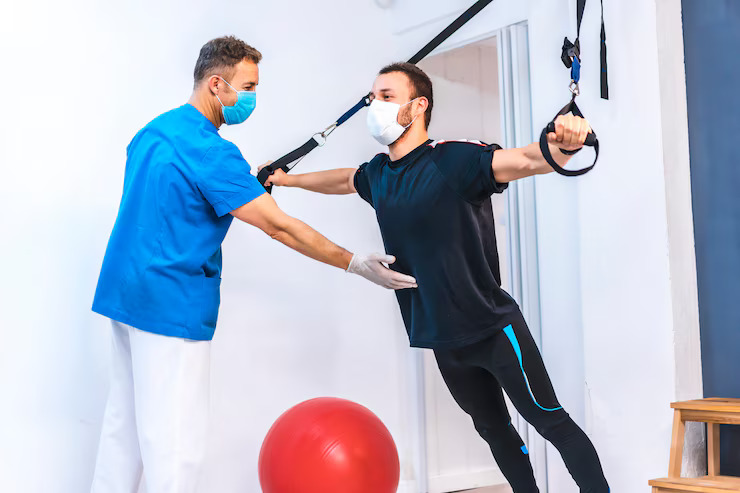
Physiotherapy is an essential branch of healthcare that aims to improve mobility, reduce pain, and restore function. One of the most widely used approaches within physiotherapy is manual therapy, a hands-on technique applied by skilled physiotherapists to treat musculoskeletal issues. Whether you’re recovering from an injury, dealing with chronic pain, or simply seeking to improve your mobility, manual therapy can offer relief.
This blog will explore manual therapy, the techniques used, and how it can benefit you.
What is Manual Therapy?
Manual therapy refers to physiotherapists’ techniques for manipulating and mobilizing muscles, joints, and soft tissues. Unlike exercises or machines, manual treatment is done entirely by hand, making it a personalized and direct form of therapy. This approach can be especially effective for addressing pain, stiffness, or injuries related to the musculoskeletal system.
Physiotherapists use manual therapy to assess and treat problems such as:
- Back pain
- Neck pain
- Joint stiffness
- Muscle tension
- Sports injuries
- Post-surgical rehabilitation
By using their hands, therapists can feel areas of restriction, tension, or imbalance in your body and apply targeted techniques to promote healing.
Why is Manual Therapy Important?
Manual therapy is crucial for restoring normal movement and function to joints and tissues. Whether you’ve experienced a sports injury, undergone surgery, or suffer from chronic pain, manual therapy can help in various ways:
- Pain Relief: One of the primary benefits is reducing pain. Manual therapy targets tight muscles, restricted joints, and irritated nerves, helping to alleviate discomfort.
- Improved Mobility: Therapists can improve the range of motion in joints through joint mobilization, which can be beneficial after an injury or surgery.
- Reduced Muscle Tension: Manual therapy helps relax tight muscles and break down scar tissue, making it easier for your body to heal.
- Personalized Treatment: Since it’s hands-on, manual therapy is tailored to your specific needs, focusing on areas that need attention the most.
Now, let’s examine some of the most common manual physiotherapy techniques.
1. Soft Tissue Mobilization
Soft tissue mobilization treats issues related to muscles, ligaments, and tendons. It’s particularly effective for reducing muscle tension, promoting blood flow, and breaking up scar tissue.
How it Works:
- The therapist uses their hands to pressure and stretch the affected soft tissues.
- Techniques like deep tissue massage or trigger point therapy may release knots (trigger points) that are causing pain or stiffness.
- Soft tissue mobilization is often used to reduce adhesions in conditions like lower back pain, shoulder tightness, or after surgery.
Benefits:
- Increased blood circulation to the affected areas
- Decreased muscle spasms and tension
- Improved flexibility and range of motion
For example, if you have tension in your neck and shoulders from poor posture, your physiotherapist may use soft tissue mobilization to relieve tightness in the muscles.
2. Joint Mobilization
Joint mobilization is a gentle, hands-on technique that involves moving a joint through its natural range of motion. This technique is particularly useful for joints that have become stiff due to injury, arthritis, or surgery.
How it Works:
- The therapist applies slow, controlled movements to the joint, often working in different directions to improve mobility.
- Depending on the severity of the restriction, mobilization can vary from small oscillations to larger, more sustained movements.
Benefits:
- Restored joint movement
- Reduced pain and stiffness
- Improved alignment and function
For instance, if your knee is stiff after surgery, joint mobilization can help improve its range of motion and speed up recovery.
3. Manipulation (High-Velocity, Low-Amplitude Thrust)
Manipulation is a more advanced manual therapy technique that involves applying a quick, controlled thrust to a joint. This technique is often associated with a “popping” or “clicking” sound and restores movement to locked or restricted joints.
How it Works:
- The therapist positions the joint in a specific way and applies a quick, low-force movement.
- This can help “unlock” the joint and restore its proper alignment and function.
Benefits:
- Immediate pain relief
- Improved joint mobility
- Reduced muscle tension surrounding the joint
Manipulation is commonly used for the spine, helping to relieve lower back or neck pain caused by misaligned vertebrae.
4. Myofascial Release
The fascia is connective tissue surrounding your muscles, bones, and organs. It can cause pain and limit movement when it becomes tight or restricted. Myofascial release focuses on relieving tension in the fascia.
How it Works:
- The therapist applies gentle pressure to the fascia, holding it for a few minutes until the tissue relaxes and releases.
- This technique can be used on various body parts, especially areas with chronic tension, such as the neck, back, or legs.
Benefits:
- Reduced pain and tightness
- Improved movement in the affected area
- Release of muscle knots and adhesions
If you suffer from chronic conditions like fibromyalgia, myofascial release can help manage pain and discomfort.
5. Trigger Point Therapy
Trigger points are tight areas within a muscle that cause pain and discomfort. They can sometimes refer pain to other places, making it difficult to identify the root cause. Trigger point therapy is a technique where the therapist applies pressure to these specific points to release tension.
How it Works:
- The therapist identifies the trigger points by feeling for knots or tight bands in the muscle.
- They apply sustained pressure until the point is released, reducing pain and improving flexibility.
Benefits:
- Reduced localized and referred pain
- Increased range of motion
- Relief from chronic tension headaches, neck pain, or back pain
If you’ve ever felt a sharp pain in your shoulder or neck that radiates to other areas, trigger point therapy can be a game-changer.
6. Craniosacral Therapy
Craniosacral therapy is a more subtle manual therapy technique focusing on the skull, spine, and sacrum (the area between the spine and the pelvis). It is designed to release tension in the central nervous system, promoting relaxation and pain relief.
How it Works:
- The therapist uses light touch to feel for cranial bones and sacrum movement restrictions.
- Gentle manipulation of these areas helps to restore balance and ease tension.
Benefits:
- Relief from headaches and migraines
- Reduced tension in the neck and back
- Improved nervous system function
Craniosacral therapy is particularly beneficial for individuals with chronic pain, migraines, or tension-related conditions.
Final Thoughts
Manual therapy offers a highly effective, personalized approach to physiotherapy. It provides various techniques that can be tailored to your specific needs. Manual therapy can play a significant role in your rehabilitation journey, whether dealing with joint stiffness, muscle tension, or recovering from an injury.
By working directly with your physiotherapist, you’ll receive hands-on care that targets the exact source of your pain or dysfunction. This will help you regain mobility and live a healthier, pain-free life.
If you’re considering physiotherapy or manual therapy in seawoods, consult a certified therapist to find the best treatment plan for your condition. Expert physiotherapists in Seawoods at IVORY PHYSIOTHERAPY CLINIC are here to help guide you through effective treatment plans for faster healing. Reach out today!







